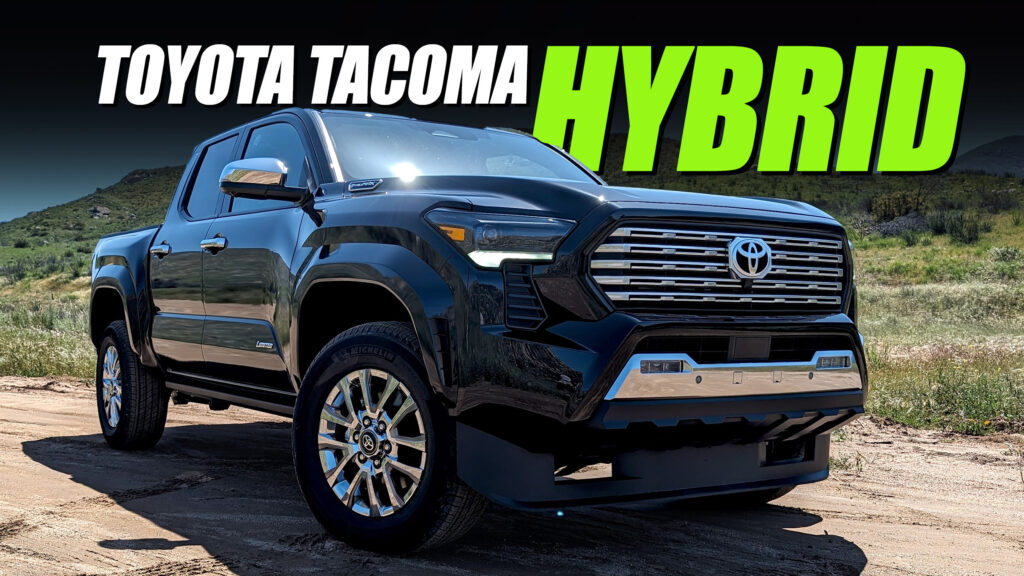
Picking out the right Tacoma for you is like selecting the perfect dog breed to bring into your home, and the hybrid option adds another layer to this analogy
2 hours ago
The 2024 Tacoma is a significant truck, not just for Toyota, but for the segment overall. It marks the debut of the first mid-size hybrid pickup in the U.S. market, potentially signaling the end of having to choose between capability and fuel economy. Its introduction in May of 2023 received widespread positive reactions, but upon its launch in December, one major feature was notably absent: the hybrid drivetrain Toyota had previously touted nearly a year ago.
Now, it’s finally ready, and it will be at dealers within weeks. Upon arrival, it will bring with it 326 hp (243 kW) and 465 lb-ft (629 Nm) of torque from its i-FORCE Max hybridized 2.4-liter turbocharged four-cylinder engine, which essentially replaces last year’s optional 3.5-liter V6. Power is distributed to all four wheels via an eight-speed automatic gearbox, and it is expected to achieve up to 24 mpg.
Review: 2024 Toyota Land Cruiser Is The 4-Runner For Grown Ups
To see if it lives up to its claims, we traveled to San Diego, California for our first drive with the Tacoma. We tested the Limited trim on the road, navigated the Trailhunter off-road through a trail with numerous obstacles, and tackled a high-speed baja-style course with the TRD Pro. We found out that picking the right Tacoma is sort of like picking the right dog breed.
Quick Facts
A Cozy Cabin
The interior of the Tacoma is well-known at this stage in the game. The non-hybrid version dropped several months ago and the i-Force MAX doesn’t change much in the cabin. The dash, door cards and center console all feature mostly squared-off design elements. It’s a cohesive space that looks rugged and appropriate. Does some of it feel cheap? Yes. Will it stand up to the test of time? Likely better than a bunch of soft-touch materials would have.
The front seats are either six or eight-way adjustable depending on trim. That made it easy to get comfortable though we’d love to see even more settings to dial in upper seat comfort, thigh bolstering, and more.
A 12.3-inch digital gauge cluster is standard on every Taco that comes with the hybrid engine and it’s paired with either an 8- or 14-inch infotainment system depending on the trim in question. Toyota also includes a complete set of buttons, knobs, and switches, which is a big win. There’s no need to dig deep into a touchscreen to accomplish simple tasks and that’s the way it should be.
Android Auto and Apple CarPlay are both standard but the native UX is good enough that many will skip integrating their device altogether. The TRD Sport and TRD Off-Road each come with the smaller screen and six speakers while the Limited, Trailhunter, and TRD Pro get the 14-inch screen and 10 speakers. That includes the clever removable JBL bluetooth speaker in the dashboard.
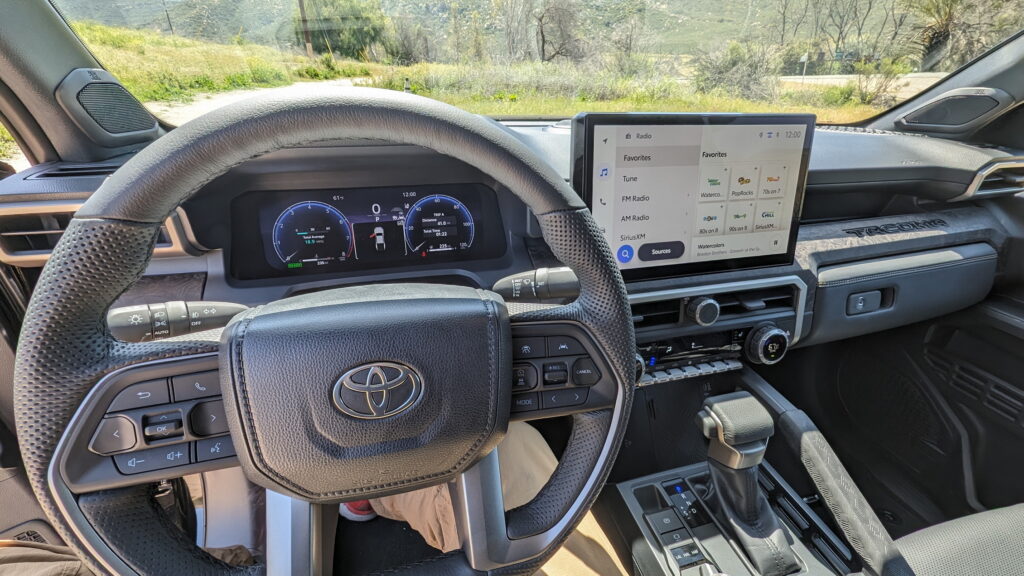
In addition, we really like the practical touches littered throughout the cabin. The MOLLE panels on the door cards and on the passenger side of the center tunnel are both functional and attractive. The shelf ahead of the front passenger seat is stylish and utilitarian, and the hidden compartment in the driver’s side of the dash provides a space for rarely needed but perhaps vital supplies.
The back seats are very very tight. That’s especially true with the thick IsoDynamic seats but it’s true even when they’re not present. At 6 ‘6, I absolutely could not fit in the back unless I laid across both seats and slouched so as to not hit my head. Toyota does offer extra storage under the seats but that’s a questionable tradeoff.
Pricing
Those who want to overland, off-road, or just go out to dinner or lunch with three other people really need to check it out before buying. I can absolutely see the lack of rear seat space being a deal breaker for some. Both the Chevrolet Colorado and Ford Ranger offer just a bit more room. Since this is a truck let’s take a moment to talk about the bed.
It measures 60.3’’x53’’ for the short bed while the long bed changes that equation to 73.5’’x53’’. It’ll handle up to 1,610 pounds of payload which is more than you’ll get from the Colorado or the Frontier. Notably, those who want the longer bed and the hybrid engine can only get that combo in the Trailhunter trim which starts at $63,400.
On-Road Ups And Downs
From the driver’s seat, the new 326hp i-Force MAX engine in the Tacoma Limited we drove is clearly more powerful than its non-hybrid sibling that rocks the same 2.4-liter turbocharged inline-four with 278 ponies.
That’s most obvious when already up to speed though. From a dead stop, the two trucks feel very similar. The non-hybrid actually feels more responsive, though. Throttle and braking inputs on the Tacoma HEV feel almost as if there’s a delay between the request for more of either and the reaction from the truck itself.
Accelerate hard for more than a few seconds and the pickup will build speed quite quickly, but when you let off it feels as though the powertrain needs an extra half-second or so before it too relents. It’s unclear if the delay is due to the hybrid engine or the transmission simply hanging onto the gear too long. Interestingly, the brakes have a similar delay on initial contact.
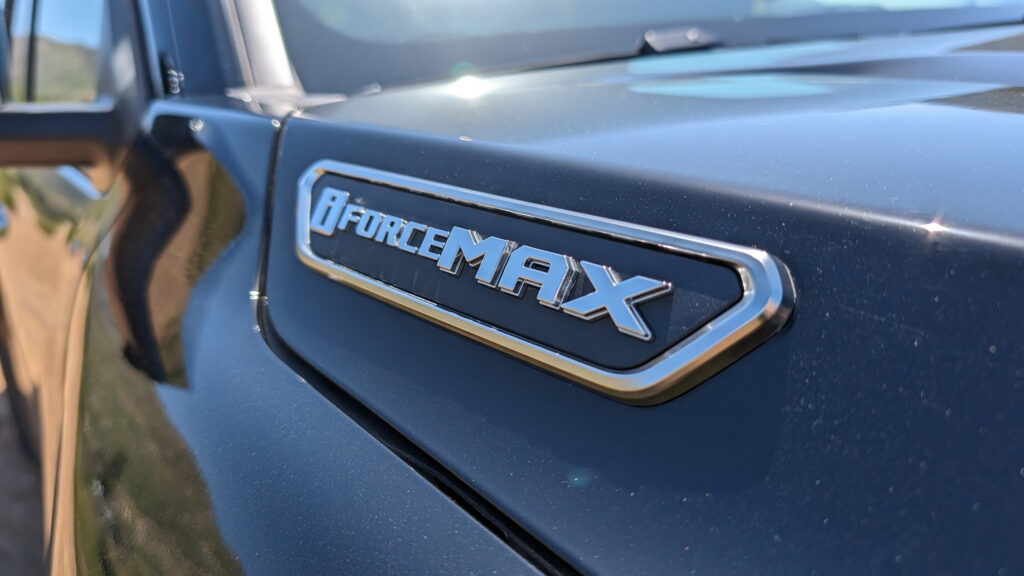
The first few degrees of pedal travel offer very little but then, it firms up fast. Bringing the truck to a stop smoothly feels as though it takes a more nuanced approach than in something like the GMC Canyon. For all of the excellent work Toyota did on the new Camry and its hybrid braking system, we’re surprised the Tacoma isn’t smoother now too.
In terms of handling though, the Tacoma feels very good compared to its rivals. The suspension isn’t jittery or wallowy either. Poor road conditions don’t upset it and it’s easy to pilot in busy parking lots and on narrow roads.
Review: 2025 Toyota Camry Hybrid Distills Its Strengths Into A More Attractive Package
Frankly, it offers far more truck than the vast majority of truck buyers will ever need, blending seamlessly with traffic in a way that exceeds the capabilities of most full-size trucks. It’s even surprisingly quiet. However, the more off-road-focused trims may not deliver the same sharpness or serenity on pavement. But then again, they’re not designed to shine on the blacktop.
Home Off-Road
During our drive, we had the chance to go off-road in the new Tacoma Trailhunter, an overlanding rig built as a turn-key adventuremobile. It comes standard with “3D multi-terrain monitor” (MTM) tech along with several other notable upgrades including Old Man Emu shocks, steel rock rails, steel underbody protection, and more.
The course we tackled was the same as the one Toyota had us drive the new Land Cruiser on so it includes lots of slippery river rock sections, a very small water crossing, a section dedicated to testing articulation, and several steep sections where the truck was tilted nearly 30 degrees.
It’s in those sections where one can’t totally see the trail ahead and where the cameras are a huge asset. Instead of simply showing the trail itself, the 3D system essentially allows you to look through the truck itself onto the trail with only the tires visible. It almost makes having a spotter obsolete.
Toyota also gave us the chance to drive around a high-speed off-road stage in the new Tacoma TRD Pro. There, we tested out the new IsoDynamic seats while jumping the pickup at over 40 mph and it’s on these off-road trails where the Tacoma feels most at home. It’s sincerely capable and feels far more rewarding to drive on dirt at any speed than it does on pavement. The engine and gearbox work in harmony and features like CRAWL control enable sure-footed grip.
Having not driven a Tacoma without the IsoDynamic seats on the same trail, it’s hard to say just how effective they are. At the same time, the ride was surprisingly smooth and comfortable. I even managed to avoid hitting my head on landing the truck after the jump. Due to the limited interior space that was a bit surprising even though I ducked a bit too.
Fuel Economy
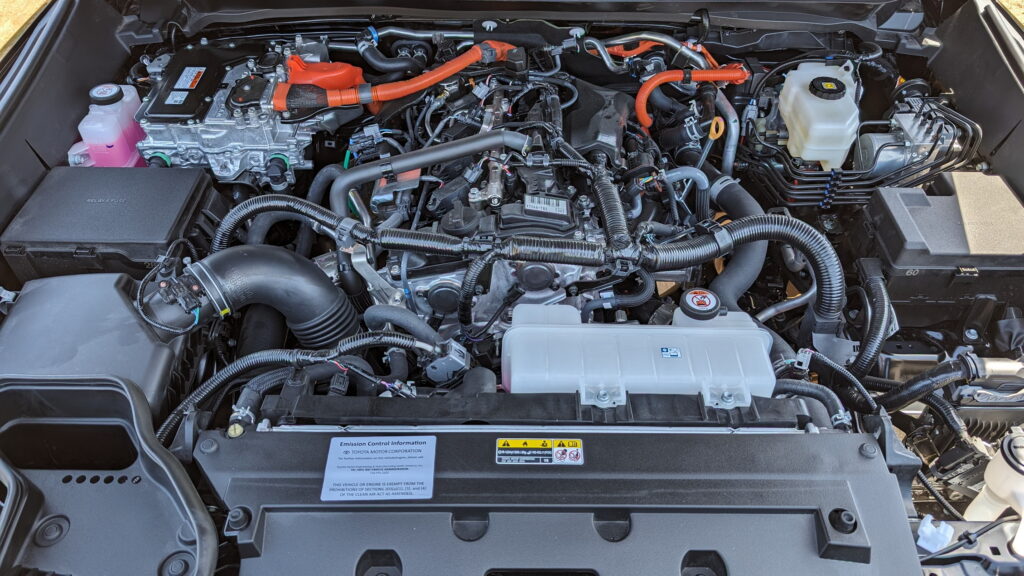
In our brief time in the Tacoma HEV, the truck managed 19.7 mpg combined in a mix of driving conditions. Notably, it did not include the off-road testing we did in the Tacoma Trailhunter. That figure is also close to the average economy (20 mpg) of rivals like the Chevrolet Colorado and Nissan Frontier. Granted, the Tacoma makes more power and, according to Toyota, can get up to 24 mpg combined.
Some might consider that figure to be a bit of a letdown. After all, the non-hybrid gets 23 mpg combined. Interestingly, the GMC Sierra with a 3.0-liter diesel also gets 23 mpg combined while boasting almost the same horsepower and even more torque. Would the Tacoma have been better off with a similar diesel setup instead of a more complex hybrid engine? Possibly – but we’ll never know.
It’ll be several years before we know just how reliable this powertrain is in this truck. For the time being, the numbers on paper look great. It offers considerably more power than in the non-hybrid while eeking out just a bit better fuel economy.
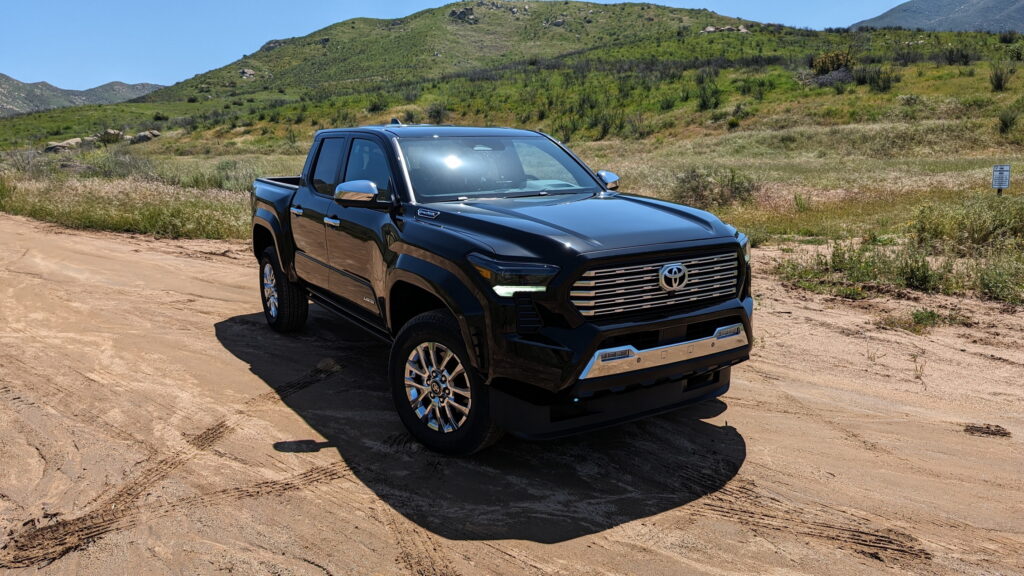
Conclusions
The Tacoma is a very capable pickup wherever the i-Force MAX engine is employed. The TRD Pro and Trailhunter are exceptional off-road. The Limited feels planted, comfortable, and more than powerful enough for everyday duty. Still, the non-hybrid feels like the better value for dollar overall since the Tacoma HEV starts at $46,300 (if dealers will actually charge MSRP).
For example, the non-hybrid Limited trim starts at $52,100 and comes with just about everything most drivers will ever need. The non-hybrid trims are also available with a manual gearbox which is sadly lacking from the HEV version.
On the other side of the coin, the market for turn-key off-road trucks is clearly healthy. GMC, Chevrolet, and Ford are all in that game and so it’s no surprise that Toyota joined the fray. What’s great is that it did so with a sincerely excellent entry that is just as capable as any of those rivals. Not only that, but buyers get a choice of what style of off-roading they prefer from baja-style driving to rock crawling to overlanding.
Sure, it’ll cost quite a lot to get into that game but owners will benefit from a full warranty at the same time. On top of that, it’s the only way to get a hybrid in the mid-size pickup segment, as the only other option is the compact-sized Ford Maverick which is an entirely different beast. For what it’s worth, while we don’t get it here in the States, the Ranger is available as a plug-in hybrid in other markets.
The big key with the Tacoma though is buying the right trim. Picking one that fits with your lifestyle feels akin to picking the right breed of dog to bring into your home. There’s a wide array of available choices with all sorts of varying capabilities and features. Having an Irish Wolfhound cooped up in an apartment is a disservice to everyone, and trying to take a Chihuahua big game hunting is too. Pick the one that fits your actual lifestyle and chances are it will win you over.
